编译原理复习
《编译原理》期末复习资料(完整版)
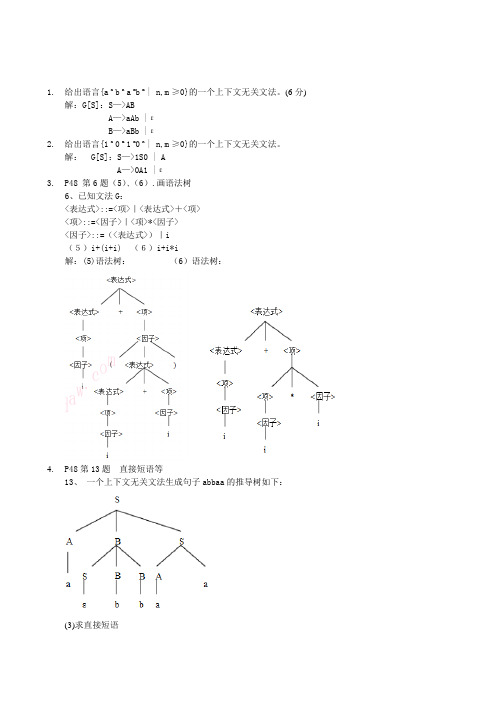
1.给出语言{a n b n a m b m | n,m≥0}的一个上下文无关文法。
(6分)解:G[S]:S—>ABA—>aAb |εB—>aBb |ε2.给出语言{1 n 0 m 1 m0 n | n,m≥0}的一个上下文无关文法。
解:G[S]:S—>1S0 | AA—>0A1 |ε3.P48 第6题(5)、(6).画语法树6、已知文法G:<表达式>::=<项>|<表达式>+<项><项>::=<因子>|<项>*<因子><因子>::=(<表达式>)|i(5)i+(i+i) (6)i+i*i解:(5)语法树:(6)语法树:4.P48第13题直接短语等13、一个上下文无关文法生成句子abbaa的推导树如下:(3)求直接短语解:直接短语有:a ε bP102例题6.1及其分析.( 后加画语法树)例6.1 设文法G[S]为:(1)S—>aAcBe(2)A—>b(3)A—>Ab(4)B—>d对输入串abbcde#进行分析,检查该符号串是否是G[S]的句子。
步骤符号栈输入符号串动作(1)# abbcde# 移进(2)#a bbcde# 移进(3)#ab bcde# 归约(A—>b)(4)#aA bcde#移进(5)#aAb cde# 归约(A—>Ab)(6)#aA cde# 移进(7)#aAc de# 移进(8)#aAcd e# 归约(B—>d)(9)#aAcB e# 移进(10)#aAcBe # 归约(S—>aAcBe)(11)#S # 接受一、计算分析题(60%)1、正规式→ NFA→ DFA→最简DFAP72第1题(1)、(4);第一题1、构造下列正规式相应的DFA.(1)1(0|1)*101解:先构造NFA0 1S AA A ABAB AC ABAC A ABZABZ AC AB除S,A外,重新命名其他状态,令AB为B、AC为C、ABZ为D,因为D含有Z(NFA的终态),所以0 1S AA A BB C BC A DD C B(4) b((ab)*|bb)*ab解:先构造NFA得到DFA如下所示:P72第4题(a)4、把下图确定化和最小化解:确定化:a b0 01 101 01 11 0、{1},其中A为初态,A,B为终态,因此有:a bA B CB B CC A最小化::初始分划得终态组{A,B},非终态组{C}Π0:{A,B},{C},对终态组进行审查,判断A和B是等价的,故这是最后的划分。
编译原理复习题有答案

编译原理复习题有答案编译原理复习题及答案一、选择题1. 编译器的主要功能是什么?A. 代码格式化B. 代码优化C. 将源代码转换为机器码D. 错误检测和修复答案:C2. 词法分析阶段的主要任务是什么?A. 语法分析B. 语义分析C. 识别源程序中的词法单元D. 代码生成答案:C3. 下列哪个不是编译原理中的常见数据结构?A. 栈B. 队列C. 哈希表D. 链表答案:D4. 语法分析通常采用哪种方法?A. 递归下降分析B. 动态规划C. 贪心算法D. 深度优先搜索答案:A5. 代码优化的目的是什么?A. 增加程序长度B. 减少程序运行时间C. 提高程序的可读性D. 增加程序的复杂性答案:B二、简答题1. 简述编译过程的主要阶段。
答案:编译过程主要分为四个阶段:词法分析、语法分析、语义分析和代码生成。
词法分析负责将源代码分解成词法单元;语法分析构建语法树,检查源代码的语法结构;语义分析检查程序的语义正确性;代码生成将源代码转换成目标代码或机器码。
2. 什么是自底向上的语法分析方法?答案:自底向上的语法分析方法是一种从叶子节点开始,逐步向上构建语法树的方法。
它通常使用移进-归约分析技术,通过将输入符号与栈顶符号进行匹配,不断地将它们归约成非终结符,直到整个输入被归约为起始符号。
3. 请解释什么是中间代码,并说明其作用。
答案:中间代码是一种介于源代码和目标代码之间的代码形式,通常用于代码优化和目标代码生成。
它具有高级语言的可读性,同时又能表达程序的控制流和数据流信息。
中间代码使得编译器可以在不同的阶段对程序进行优化,提高程序的执行效率。
三、论述题1. 论述编译原理中的错误处理机制。
答案:编译原理中的错误处理机制主要包括错误检测、错误恢复和错误报告。
错误检测是指在编译过程中识别出源代码中的语法或语义错误;错误恢复是指在检测到错误后,编译器采取的措施以继续编译过程,避免因单个错误而中断整个编译;错误报告则是向程序员提供错误信息,帮助其定位和修复错误。
编译原理第三版期末复习

期末复习总结《编译原理》第一章:绪论一、填空问题①由于计算机只能认识机器语言,所以需要翻译程序将高级语言翻译成计算机可以识别的机器语言。
②编译程序的工作过程一般主要划分为词法分析,语法分析,中间代码生成,代码优化,目标代码生成等几个基本阶段,同时还会伴有表格管理和出错处理。
③如果编译程序生成的目标程序是机器代码程序,则源程序的执行分为两个阶段:编译阶段和运行阶段。
如果编译程序生成的目标程序是汇编语言的程序,则源程序的执行分为三个阶段:编译阶段,汇编阶段和运行阶段。
1-02.若源程序是用高级语言编写的,目标程序是机器语言程序或汇编程序 ,则其翻译程序称为编译程序.1-03.编译方式与解释方式的根本区别在于是否生成目标代码 .1-05.对编译程序而言,输入数据是源程序,输出结果是目标程序 .1-10.一个编译程序中,不仅包含词法分析,语法分析,中间代码生成,代码优化,目标代码生成等五个部分,还应包括(1)c.其中, (2)b 和代码优化部分不是每个编译程序都必需的. 词法分析器用于识别 (3)c ,语法分析器则可以发现源程序中的 (4)d .(1) a.模拟执行器 b.解释器 c.表格处理和出错处理 d.符号执行器(2) a.语法分析 b.中间代码生成 c.词法分析 d.目标代码生成(3) a.字符串 b.语句 c.单词 d.标识符(4) a.语义错误 b.语法和语义错误 c.错误并校正 d.语法错误1-11.程序语言的语言处理程序是一种 (1)a . (2)b 是两类程序语言处理程序,他们的主要区别在于 (3)d .(1) a.系统软件 b.应用软件 c.实时系统 d.分布式系统(2) a.高级语言程序和低级语言程序 b.解释程序和编译程序c.编译程序和操作系统d.系统程序和应用程序(3) a.单用户与多用户的差别 b.对用户程序的查错能力c.机器执行效率d.是否生成目标代码1-12.汇编程序是将 a 翻译成 b ,编译程序是将 c 翻译成 d .a.汇编语言程序b.机器语言程序c.高级语言程序d. a 或者 be. a 或者 cf. b 或者 c1-13.下面关于解释程序的描述正确的是 b .(1) 解释程序的特点是处理程序时不产生目标代码(2) 解释程序适用于COBOL 和 FORTRAN 语言(3) 解释程序是为打开编译程序技术的僵局而开发的a. (1)(2)b. (1)c. (1)(2)(3)d.(2)(3)1-14.高级语言的语言处理程序分为解释程序和编译程序两种.编译程序有五个阶段,而解释程序通常缺少 (1)e 和 (1)b .其中, (1)e 的目的是使最后阶段产生的目标代码更为高效.与编译系统相比,解释系统 (2)d .解释程序处理语言时,大多数采用的是 (3)b 方法.(1): a. 中间代码生成 b.目标代码生成 c.词法分析 d.语法分析 e.代码优化(2): a.比较简单,可移植性好,执行速度快b.比较复杂,可移植性好,执行速度快c.比较简单,可移植性差,执行速度慢d.比较简单,可移植性好,执行速度慢(3): a.源程序命令被逐个直接解释执行 b.先将源程序转化为之间代码,再解释执行c.先将源程序解释转化为目标程序,在执行d.以上方法都可以1-15.用高级语言编写的程序经编译后产生的程序叫 b .用不同语言编写的程序产生 a 后,可用 g 连接在一起生成机器可执行的程序.在机器中真正执行的是 e .a. 源程序b. 目标程序c. 函数d. 过程e. 机器指令代码f. 模块g. 连接程序h.程序库1-16.要在某一台机器上为某种语言构造一个编译程序,必须掌握下述三方面的内容: c , d , f .a. 汇编语言b. 高级语言c. 源语言d. 目标语言e. 程序设计方法f. 编译方法g. 测试方法h. 机器语言1-17.由于受到具体机器主存容量的限制,编译程序几个不同阶段的工作往往被组合成(1)d ,诸阶段的工作往往是 (2)d 进行的.(1) a. 过程 b. 程序 c. 批量 d.遍(2) a. 顺序 b. 并行 c. 成批 d.穿插1-18.编译程序与具体的机器 a , 与具体的语言 a .a. 有关b.无关1-19.使用解释程序时,在程序未执行完的情况下, a 重新执行已执行过的部分.a. 也能b.不可能1-20.编译过程中,语法分析器的任务就是 b .(1) 分析单词是怎样构成的(2)分析单词串是如何构成语句和说明的(3) 分析语句和说明是如何构成程序的 (4) 分析程序的结构a. (2)(3)b. (2)(3)(4)c. (1)(2)(3)d.(1)(2)(3)(4)1-21.编译程序是一种常用的 b 软件.a. 应用b. 系统1-22.编写一个计算机高级语言的源程序后,到正式上机运行之前,一般要经过 b 这几步.(1) 编辑 (2) 编译 (3) 连接 (4) 运行a. (1)(2)(3)(4)b. (1)(2)(3)c. (1)(3)d.(1)(4)1-23.编译程序必须完成的工作有 a .(1) 词法分析 (2) 语法分析 (3) 语义分析(4) 代码生成 (5) 之间代码生成 (6) 代码优化a. (1)(2)(3)(4)b. (1)(2)(3)(4)(5)c. (1)(2)(3)(4)(5)(6)d. (1)(2)(3)(4)(6)e. (1)(2)(3)(5)(6)1-24.“用高级语言书写的源程序都必须通过编译,产生目标代码后才能投入运行”这种说法a .a. 不正确b.正确1-25.把汇编语言程序翻译成机器可执行的目标程序的工作是由 b 完成的.a. 编译器b. 汇编器c. 解释器d. 预处理器1-26.编译程序生成的目标程序 b 是机器语言的程序.a. 一定b. 不一定1-27.编译程序生成的目标程序 b 是可执行的程序.a. 一定b. 不一定1-28.编译程序是一种 B 。
编译原理复习重点含答案
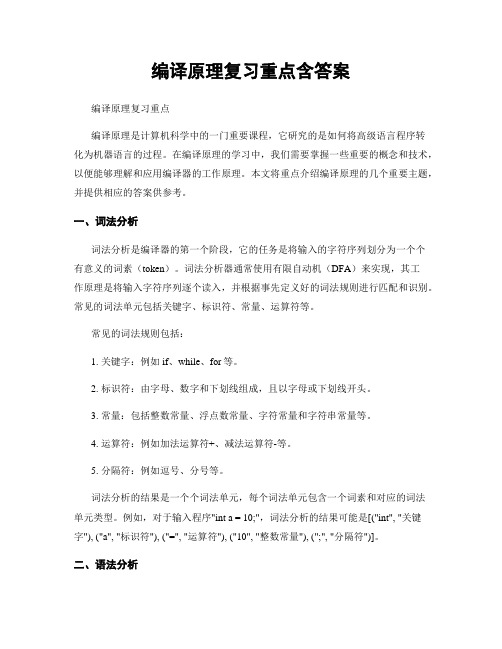
编译原理复习重点含答案编译原理复习重点编译原理是计算机科学中的一门重要课程,它研究的是如何将高级语言程序转化为机器语言的过程。
在编译原理的学习中,我们需要掌握一些重要的概念和技术,以便能够理解和应用编译器的工作原理。
本文将重点介绍编译原理的几个重要主题,并提供相应的答案供参考。
一、词法分析词法分析是编译器的第一个阶段,它的任务是将输入的字符序列划分为一个个有意义的词素(token)。
词法分析器通常使用有限自动机(DFA)来实现,其工作原理是将输入字符序列逐个读入,并根据事先定义好的词法规则进行匹配和识别。
常见的词法单元包括关键字、标识符、常量、运算符等。
常见的词法规则包括:1. 关键字:例如if、while、for等。
2. 标识符:由字母、数字和下划线组成,且以字母或下划线开头。
3. 常量:包括整数常量、浮点数常量、字符常量和字符串常量等。
4. 运算符:例如加法运算符+、减法运算符-等。
5. 分隔符:例如逗号、分号等。
词法分析的结果是一个个词法单元,每个词法单元包含一个词素和对应的词法单元类型。
例如,对于输入程序"int a = 10;",词法分析的结果可能是[("int", "关键字"), ("a", "标识符"), ("=", "运算符"), ("10", "整数常量"), (";", "分隔符")]。
二、语法分析语法分析是编译器的第二个阶段,它的任务是将词法分析器输出的词法单元序列转化为抽象语法树(AST)。
语法分析器通常使用上下文无关文法(CFG)来描述语言的语法结构,并使用递归下降、LL(1)分析、LR分析等算法进行分析。
常见的语法规则包括:1. 表达式:例如算术表达式、布尔表达式等。
编译原理期末总结复习

编译原理期末总结复习(经典版)编制人:__________________审核人:__________________审批人:__________________编制单位:__________________编制时间:____年____月____日序言下载提示:该文档是本店铺精心编制而成的,希望大家下载后,能够帮助大家解决实际问题。
文档下载后可定制修改,请根据实际需要进行调整和使用,谢谢!并且,本店铺为大家提供各种类型的经典范文,如公文写作、报告体会、演讲致辞、党团资料、合同协议、条据文书、诗词歌赋、教学资料、作文大全、其他范文等等,想了解不同范文格式和写法,敬请关注!Download tips: This document is carefully compiled by this editor. I hope that after you download it, it can help you solve practical problems. The document can be customized and modified after downloading, please adjust and use it according to actual needs, thank you!In addition, this shop provides you with various types of classic sample essays, such as official document writing, report experience, speeches, party and group materials, contracts and agreements, articles and documents, poems and songs, teaching materials, essay collections, other sample essays, etc. Learn about the different formats and writing styles of sample essays, so stay tuned!编译原理期末总结复习编译原理期末总结复习(精选3篇)编译原理期末总结复习篇1一、简答题1.什么是编译程序?答:编译程序是一种将高级语言程序(源程序)翻译成低级语言(目标程序)的程序。
编译原理总复习

中间代码生成的自动生成工具
工具介绍
自动生成工具是一种辅助编译器设计的软件工具,它可以自动生成中间代码,从而简化编 译器的设计和实现过程。
工具分类
根据生成中间代码的方式不同,自动生成工具可以分为解析型和抽象语法树型两类。解析 型工具将源代码直接翻译成中间代码;抽象语法树型工具则将源代码先转换为抽象语法树 ,然后再将抽象语法树转换为中间代码。
Antlr
一个强大的语法分析器生成器,支持多种语言和复杂 的文法规则。
GOLD
一个高效的语法分析器生成器,支持多种目标语言和 优化选项。
04 中间代码生成
中间代码生成的定义与任务
定义
中间代码生成是编译过程的一个阶段,将源代码转化为一种中间表示形式,这种中间表 示形式称为中间代码。
任务
其任务包括控制结构的抽象、语义的消除、代码优化等,以简化后续的代码优化和目标 代码生成阶段。
循环结构的优化
循环展开
将循环体中的代码复制到循环 外部,以减少循环次数。
循环合并
将多个循环合并为一个循环, 以减少循环次数。
循环嵌套
将一个循环嵌套在另一个循环 内部,以减少循环次数。
循环展开与循环合并的优 缺点
循环展开可以减少循环次数, 但会增加代码量;循环合并可 以减少代码量,但会增加循环 次数。在实际应用中,需要根 据具体情况选择合适的优化方 法。
算法优化
根据问题的特点,选择合适的算法,以提高程序 执行效率。
系统资源优化
根据系统资源的特点,合理分配和利用系统资源, 以提高系统运行效率。
循环优化
1 2
循环展开
将循环体中的操作展开,以减少循环次数和减少 循环开销。
循环合并
将多个循环合并为一个循环,以减少循环次数和 减少循环开销。
编译原理知识点汇总

编译原理的复习提纲1.编译原理=形式语言+编译技术2.汇编程序:把汇编语言程序翻译成等价的机器语言程序3.编译程序:把高级语言程序翻译成等价的低级语言程序4.解释执行方式:解释程序,逐个语句地模拟执行翻译执行方式:翻译程序,把程序设计语言程序翻译成等价的目标程序5.计算机程序的编译过程类似,一般分为五个阶段:词法分析、语法分析、语义分析及中间代码生成、代码优化、目标代码生成词法分析的任务:扫描源程序的字符串,识别出的最小的语法单位(标识符或无正负号数等)语法分析是:在词法分析的基础上的,语法分析不考虑语义。
语法分析读入词法分析程序识别出的符号,根据给定的语法规则,识别出各个语法结构。
语义分析的任务是检查程序语义的正确性,解释程序结构的含义,语义分析包括检查变量是否有定义,变量在使用前是否具有值,数值是否溢出等。
语法分析完成之后,编译程序通常就依据语言的语义规则,利用语法制导技术把源程序翻译成某种中间代码。
所谓中间代码是一种定义明确、便于处理、独立于计算机硬件的记号系统,可以认为是一种抽象机的程序代码优化的主要任务是对前一阶段产生的中间代码进行等价变换,以便产生速度快、空间小的目标代码编译的最后一个阶段是目标代码生成,其主要任务是把中间代码翻译成特定的机器指令或汇编程序编译程序结构包括五个基本功能模块和两个辅助模块6.编译划分成前端和后端。
编译前端的工作包括词法分析、语法分析、语义分析。
编译前端只依赖于源程序,独立于目标计算机。
前端进行分析编译后端的工作主要是目标代码的生成和优化后端进行综合。
独立于源程序,完全依赖于目标机器和中间代码。
把编译程序分为前端和后端的优点是:可以优化配置不同的编译程序组合,实现编译重用,保持语言与机器的独立性。
7.汇编器把汇编语言代码翻译成一个特定的机器指令序列第二章1.符号,字母表,符号串,符号串的长度计算P18,子符号串的含义,符号串的简单运算XY,X n,2.符号串集合的概念,符号串集合的乘积运算,方幂运算,闭包与正闭包的概念P19,P20 A0 ={ε}3.重写规则,简称规则。
编译原理全复习(完整版)
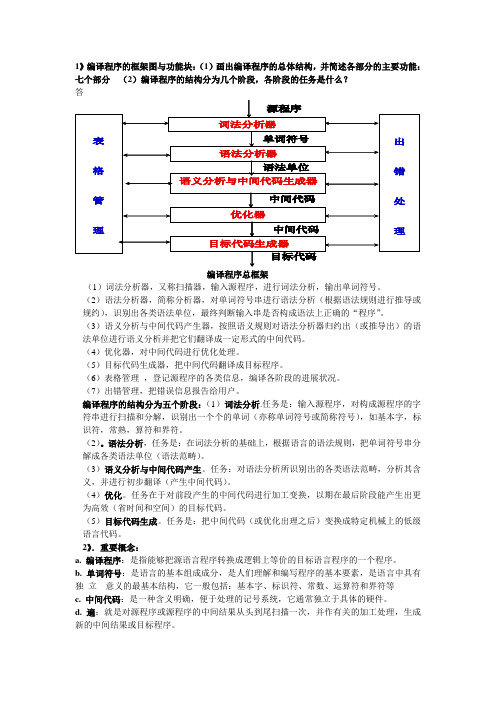
1》编译程序的框架图与功能块:(1)画出编译程序的总体结构,并简述各部分的主要功能:七个部分(2)编译程序的结构分为几个阶段,各阶段的任务是什么?答编译程序总框架(1)词法分析器,又称扫描器,输入源程序,进行词法分析,输出单词符号。
(2)语法分析器,简称分析器,对单词符号串进行语法分析(根据语法规则进行推导或规约),识别出各类语法单位,最终判断输入串是否构成语法上正确的“程序”。
(3)语义分析与中间代码产生器,按照语义规则对语法分析器归约出(或推导出)的语法单位进行语义分析并把它们翻译成一定形式的中间代码。
(4)优化器,对中间代码进行优化处理。
(5)目标代码生成器,把中间代码翻译成目标程序。
(6)表格管理,登记源程序的各类信息,编译各阶段的进展状况。
(7)出错管理,把错误信息报告给用户。
编译程序的结构分为五个阶段:(1)词法分析.任务是:输入源程序,对构成源程序的字符串进行扫描和分解,识别出一个个的单词(亦称单词符号或简称符号),如基本字,标识符,常熟,算符和界符。
(2)。
语法分析,任务是:在词法分析的基础上,根据语言的语法规则,把单词符号串分解成各类语法单位(语法范畴)。
(3)语义分析与中间代码产生。
任务:对语法分析所识别出的各类语法范畴,分析其含义,并进行初步翻译(产生中间代码)。
(4)优化。
任务在于对前段产生的中间代码进行加工变换,以期在最后阶段能产生出更为高效(省时间和空间)的目标代码。
(5)目标代码生成。
任务是:把中间代码(或优化出理之后)变换成特定机械上的低级语言代码。
2》.重要概念:a. 编译程序:是指能够把源语言程序转换成逻辑上等价的目标语言程序的一个程序。
b. 单词符号:是语言的基本组成成分,是人们理解和编写程序的基本要素,是语言中具有独立意义的最基本结构,它一般包括:基本字、标识符、常数、运算符和界符等c. 中间代码:是一种含义明确,便于处理的记号系统,它通常独立于具体的硬件。
编译原理 期末复习
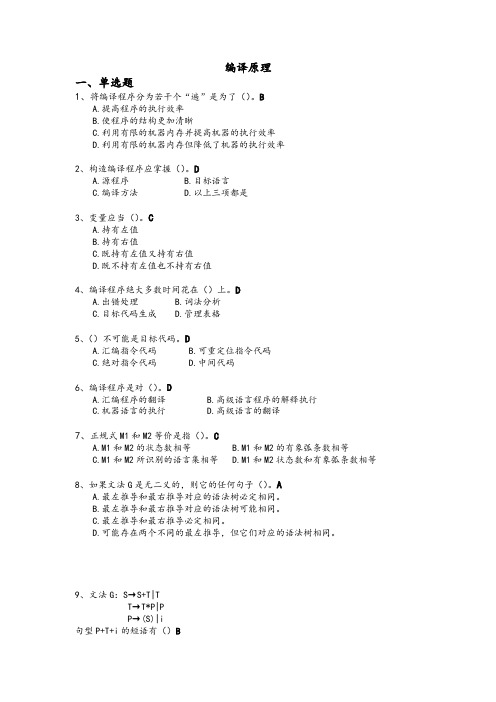
编译原理一、单选题1、将编译程序分为若干个“遍”是为了()。
BA.提高程序的执行效率B.使程序的结构更加清晰C.利用有限的机器内存并提高机器的执行效率D.利用有限的机器内存但降低了机器的执行效率2、构造编译程序应掌握()。
DA.源程序B.目标语言C.编译方法D.以上三项都是3、变量应当()。
CA.持有左值B.持有右值C.既持有左值又持有右值D.既不持有左值也不持有右值4、编译程序绝大多数时间花在()上。
DA.出错处理B.词法分析C.目标代码生成D.管理表格5、()不可能是目标代码。
DA.汇编指令代码B.可重定位指令代码C.绝对指令代码D.中间代码6、编译程序是对()。
DA.汇编程序的翻译B.高级语言程序的解释执行C.机器语言的执行D.高级语言的翻译7、正规式M1和M2等价是指()。
CA.M1和M2的状态数相等B.M1和M2的有象弧条数相等C.M1和M2所识别的语言集相等D.M1和M2状态数和有象弧条数相等8、如果文法G是无二义的,则它的任何句子()。
AA.最左推导和最右推导对应的语法树必定相同。
B.最左推导和最右推导对应的语法树可能相同。
C.最左推导和最右推导必定相同。
D.可能存在两个不同的最左推导,但它们对应的语法树相同。
9、文法G:S→S+T|TT→T*P|PP→(S)|i句型P+T+i的短语有()BA.i,P+TB. P,P+T,i,P+T +iB.P+T + i D. P,P+T,i10、产生正规语言的文法为()。
DA.0型B.1型C.2型D.3型11、文法G:S→b|˄|(T)T→T˅S|S则FIRSTVT(T)=() CA.{b,˄,(}B.{b,˄,)}C.{b,˄,(,˅}D.{b,˄,),˅}12、给定文法:A→bA | cc,下面的符号串中,为该文法句子的是()。
A①cc ②bcbc ③bcbcc ④bccbcc ⑤bbbcc可选项有:A.①B.①③④⑤C.①④D.①④⑤13、采用自上而下分析,必须()。
完整版编译原理复习题及答案
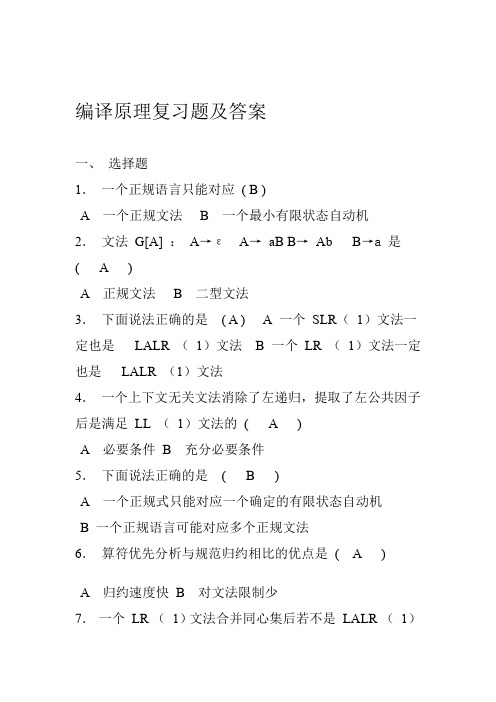
编译原理复习题及答案一、选择题1.一个正规语言只能对应( B )A 一个正规文法B 一个最小有限状态自动机2.文法G[A] :A→εA→aB B→Ab B→a是( A )A 正规文法B 二型文法3.下面说法正确的是( A ) A一个SLR(1)文法一定也是LALR (1)文法B一个LR (1)文法一定也是LALR (1)文法4.一个上下文无关文法消除了左递归,提取了左公共因子后是满足LL (1)文法的( A )A 必要条件B 充分必要条件5.下面说法正确的是( B )A 一个正规式只能对应一个确定的有限状态自动机B 一个正规语言可能对应多个正规文法6.算符优先分析与规范归约相比的优点是( A )A 归约速度快B 对文法限制少7.一个LR (1)文法合并同心集后若不是LALR (1)文法( B )A 则可能存在移进/归约冲突B 则可能存在归约/归约冲突C 则可能存在移进/归约冲突和归约/ 归约冲突8.下面说法正确的是( A )A Lex 是一个词法分析器的生成器B Yacc 是一个语法分析器9.下面说法正确的是( A )A一个正规文法也一定是二型文法B一个二型文法也一定能有一个等价的正规文法10.编译原理是对(C) 。
A 、机器语言的执行B、汇编语言的翻译C、高级语言的翻译D、高级语言程序的解释执行11.(A) 是一种典型的解释型语言。
A .BASICB .CC.FORTRAN D.PASCAL12.把汇编语言程序翻译成机器可执行的目标程序的工作是由(B) 完成的。
A. 编译器B. 汇编器C. 解释器D. 预处理器13.用高级语言编写的程序经编译后产生的程序叫(B) A .源程序B .目标程序C.连接程序 D .解释程序14.(C) 不是编译程序的组成部分。
A. 词法分析程序B. 代码生成程序C.设备管理程序D. 语法分析程序15.通常一个编译程序中,不仅包含词法分析,语法分析,语义分析,中间代码生成,代码优目标代码生成等六个部分,还应包括(C)A .模拟执行器B .解释器C.表格处理和出错处理D .符号执行器16.编译程序绝大多数时间花在(D) A .出错处理B.词法分析C.目标代码生成D.表格管理17.源程序是句子的集A. 线性表(B) 可以较好地反映句子的结构。
编译原理复习汇总
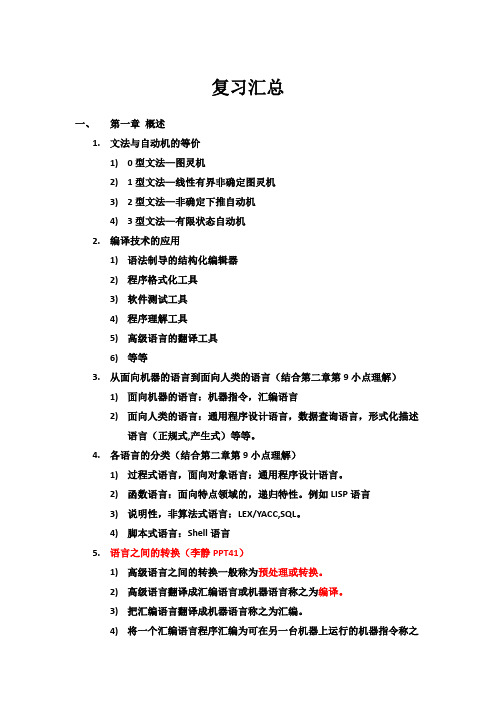
复习汇总一、第一章概述1.文法与自动机的等价1)0型文法—图灵机2)1型文法—线性有界非确定图灵机3)2型文法—非确定下推自动机4)3型文法—有限状态自动机2.编译技术的应用1)语法制导的结构化编辑器2)程序格式化工具3)软件测试工具4)程序理解工具5)高级语言的翻译工具6)等等3.从面向机器的语言到面向人类的语言(结合第二章第9小点理解)1)面向机器的语言:机器指令,汇编语言2)面向人类的语言:通用程序设计语言,数据查询语言,形式化描述语言(正规式,产生式)等等。
4.各语言的分类(结合第二章第9小点理解)1)过程式语言,面向对象语言:通用程序设计语言。
2)函数语言:面向特点领域的,递归特性。
例如LISP语言3)说明性,非算法式语言:LEX/YACC,SQL。
4)脚本式语言:Shell语言5.语言之间的转换(李静PPT41)1)高级语言之间的转换一般称为预处理或转换。
2)高级语言翻译成汇编语言或机器语言称之为编译。
3)把汇编语言翻译成机器语言称之为汇编。
4)将一个汇编语言程序汇编为可在另一台机器上运行的机器指令称之为交叉汇编。
5)把机器语言翻译成汇编语言称之为反汇编。
6)把汇编语言翻译成高级语言称之为反编译。
6.编译器和解释器1)编译器●源程序的翻译和翻译后的程序的运行是两个不同的阶段。
◆编译阶段:用户输入源程序,经过编译器的处理,生成目标程序。
◆目标程序的运行阶段:根据要求输入数据,得出结果。
2)解释器(凡是可以采用编译器的地方均可以采用解释器)●解释器把翻译和运行结合到一起,编译一段源程序,紧接着就执行它。
这种方式称为解释。
7.解释器的优点(对比与编译器)1)具有较好的动态特性。
2)具有较好的移植特性。
8.解释器的缺点(对比于编译器)1)相比于编译器需花费大量的时间。
2)占用更多的内存空间。
9.编译器的工作阶段(结合第二章6小点红色部分理解)1)源程序->词法分析器->语法分析器->语义分析器->中间代码生成器->代码优化器->目标代码生成器->目标代码2)工作过程中的每个阶段均采用了符号表管理器,出错处理器。
编译原理总复习
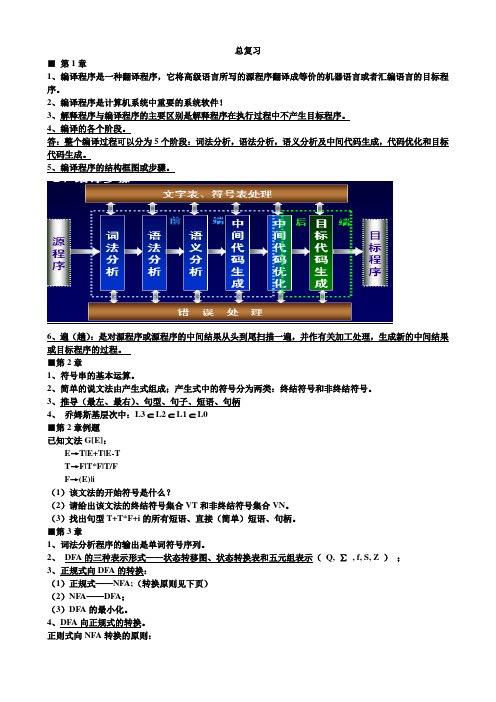
总复习■第1章1、编译程序是一种翻译程序,它将高级语言所写的源程序翻译成等价的机器语言或者汇编语言的目标程序。
2、编译程序是计算机系统中重要的系统软件!3、解释程序与编译程序的主要区别是解释程序在执行过程中不产生目标程序。
4、编译的各个阶段。
答:整个编译过程可以分为5个阶段:词法分析,语法分析,语义分析及中间代码生成,代码优化和目标代码生成。
5、编译程序的结构框图或步骤。
6、遍(趟):是对源程序或源程序的中间结果从头到尾扫描一遍,并作有关加工处理,生成新的中间结果或目标程序的过程。
■第2章1、符号串的基本运算。
2、简单的说文法由产生式组成;产生式中的符号分为两类:终结符号和非终结符号。
3、推导(最左、最右)、句型、句子、短语、句柄4、乔姆斯基层次中:L3 ⊂ L2 ⊂ L1 ⊂ L0■第2章例题已知文法G[E]:E→T|E+T|E-TT→F|T*F|T/FF→(E)|i(1)该文法的开始符号是什么?(2)请给出该文法的终结符号集合VT和非终结符号集合VN。
(3)找出句型T+T*F+i的所有短语、直接(简单)短语、句柄。
■第3章1、词法分析程序的输出是单词符号序列。
2、DFA的三种表示形式——状态转移图、状态转换表和五元组表示(Q, ∑, f, S, Z );3、正规式向DFA的转换:(1)正规式——NFA;(转换原则见下页)(2)NFA——DFA;(3)DFA的最小化。
4、DFA向正规式的转换。
正则式向NFA转换的原则:例:构造与正则表达式R=ba(a|b)*等价的状态最少的DFA,并写出该DFA的五元组形式或状态转换表。
■第4章1、语法分析方法的各种分类;2、LL(1)分析方法。
提示:在此算法中注意First集和Follow集的求法。
并且一定要注意分析过程中步骤要完整。
(分析步骤见下页总结)例:文法:S◊a|^|(T) T◊T,S|S试判断该文法是否是LL(1)文法。
习题4:P100 4.3 4.7 4.9■LL(1)分析方法相关知识总结1、消除文法中的左递归或提取左因子;(1)简单直接左递归的消除A →βA’A →Aα| β→A’ →αA’| ε(2)将文法G:A→αβ|αγ提取左因子。
编译原理复习题 全

一、单项选择题1.构造编译程序应掌握 。
Da. 源程序b. 目标语言c. 编译方法d. 以上三项都是2.编译程序绝大多数时间花在 上。
Da. 出错处理b. 词法分析c. 目标代码生成d. 表格管理3.DFA M(见图1-1)接受的字集为 。
Da. 以0开头的二进制数组成的集合b. 以0结尾的二进制数组成的集合c. 含奇数个0的二进制数组成的集合d. 含偶数个0的二进制数组成的集合4. -a-(b*c/(c-d)+(-b)*a)的逆波兰表示是 。
(@代表后缀式中的求负运算符) Ca. abc*cd-b@a*+/-@b. a@bc*cd-b@a*+/-c. a@bc*cd-/b@a*+-d. a@bc*/cd-b@a*+-5.在规范归约中,用 来刻画可归约串。
Ba. 直接短语b. 句柄c. 最左素短语d. 素短语8.有文法G 及其语法制导翻译如下所示(语义规则中的*和+分别是常规意义下的算术运算符):E →E (1) ∧ T {E.val = E (1).val * T.val}E →T {E.val = T.val}T →T (1)# n {T.val = T (1).val + n.val }T → n {T.val = n.val}则分析句子1 ∧ 2 ∧ 3 # 4其值为 。
Ca. 10b. 34c. 14d.549.如果文法G 是无二义的,则它的任何句子α 。
Aa. 最左推导和最右推导对应的语法树必定相同b. 最左推导和最右推导对应的语法树可能不同c. 最左推导和最右推导必定相同d. 可能存在两个不同的最左推导,但它们对应的语法树相同10.下列动作中,不是自下而上分析动作的是: 。
B1图1-1a. 移进b. 展开c. 接受d. 报错11.编译程序是对。
Da. 汇编程序的翻译b. 高级语言程序的解释执行c. 机器语言的执行d. 高级语言的翻译12.词法分析器的输出结果是。
Ca. 单词的种别编码b. 单词在符号表中的位置c. 单词的种别编码和自身值d. 单词自身值13.正规式M1和M2等价是指。
编译原理复习题(含试卷)
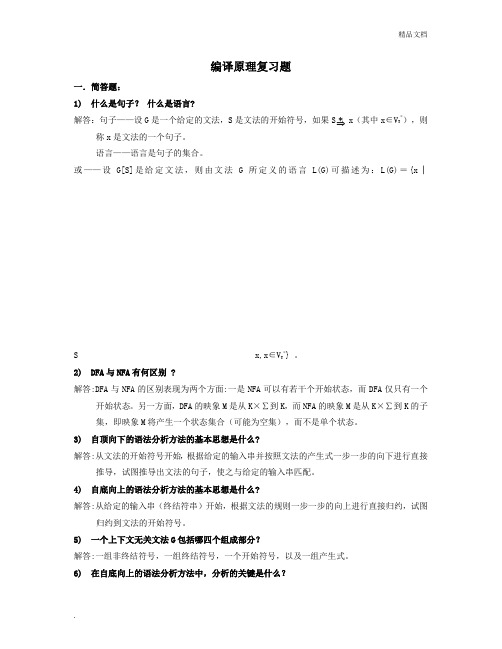
*编译原理复习题一.简答题:1) 什么是句子? 什么是语言?解答:句子——设G 是一个给定的文法,S 是文法的开始符号,如果S x (其中x ∈V T *),则称x 是文法的一个句子。
语言——语言是句子的集合。
或——设G[S]是给定文法,则由文法G 所定义的语言L(G)可描述为:L(G)={x │Sx,x ∈V T *} 。
2) DFA 与NFA 有何区别 ?解答:DFA 与NFA 的区别表现为两个方面:一是NFA 可以有若干个开始状态,而DFA 仅只有一个开始状态。
另一方面,DFA 的映象M 是从K ×∑到K ,而NFA 的映象M 是从K ×∑到K 的子集,即映象M 将产生一个状态集合(可能为空集),而不是单个状态。
3) 自顶向下的语法分析方法的基本思想是什么?解答:从文法的开始符号开始,根据给定的输入串并按照文法的产生式一步一步的向下进行直接推导,试图推导出文法的句子,使之与给定的输入串匹配。
4) 自底向上的语法分析方法的基本思想是什么?解答:从给定的输入串(终结符串)开始,根据文法的规则一步一步的向上进行直接归约,试图归约到文法的开始符号。
5) 一个上下文无关文法G 包括哪四个组成部分?解答:一组非终结符号,一组终结符号,一个开始符号,以及一组产生式。
6) 在自底向上的语法分析方法中,分析的关键是什么?解答:关键是寻找句柄。
7)在自顶向下的语法分析方法中,分析的关键是什么?解答:关键是选择候选式。
8)什么是属性文法?答:是在上下文无关文法的基础上,为每个文法符号(含终结符和非终结符)配备若干个属性值,对文法的每个产生式都配备了一组属性计算规则(称为语义规则)。
在语法分析过程中,完成语义规则所描述的动作,从而实现语义处理。
一个属性文法形式的定义为一个三元组AG,AG=(G,V,E)。
其中G为一个上下文无关文法;V为属性的有穷集;E为一组语义规则。
9)语法制导翻译语法制导翻译:定义翻译所必须的语义属性和语义规则,一般不涉及计算顺序。
编译原理复习

编译原理复习《编译原理》复习README来源⽹络&书本&PPT整理截取了⽼师课上讲解or布置的题⽬⼀些题⽬懒得贴答案了,写了些注意事项第1 章引论运⾏编译程序的计算机:宿主机运⾏编译程序所产⽣的⽬标代码的计算机:⽬标机第1 题解释下列术语:(1)编译程序:如果源语⾔为⾼级语⾔,⽬标语⾔为某台计算机上的汇编语⾔或机器语⾔,则此翻译程序称为编译程序。
(2)源程序:源语⾔编写的程序称为源程序。
(3)⽬标程序:⽬标语⾔书写的程序称为⽬标程序。
(4)编译程序的前端:它由这样⼀些阶段组成:这些阶段的⼯作主要依赖于源语⾔⽽与⽬标机⽆关。
通常前端包括词法分析、语法分析、语义分析和中间代码⽣成这些阶段,某些优化⼯作也可在前端做,也包括与前端每个阶段相关的出错处理⼯作和符号表管理等⼯作。
(5)后端:指那些依赖于⽬标机⽽⼀般不依赖源语⾔,只与中间代码有关的那些阶段,即⽬标代码⽣成,以及相关出错处理和符号表操作。
(6)遍:是对源程序或其等价的中间语⾔程序从头到尾扫视并完成规定任务的过程。
第2 题⼀个典型的编译程序通常由哪些部分组成?各部分的主要功能是什么?并画出编译程序的总体结构图。
(区别编译程序的六个阶段)答案:⼀个典型的编译程序通常包含8 个组成部分,它们是词法分析程序、语法分析程序、语义分析程序、中间代码⽣成程序、中间代码优化程序、⽬标代码⽣成程序、表格管理程序和错误处理程序。
其各部分的主要功能简述如下。
词法分析程序:输⼈源程序,拼单词、检查单词和分析单词,输出单词的机内表达形式。
语法分析程序:检查源程序中存在的形式语法错误,输出错误处理信息。
语义分析程序:进⾏语义检查和分析语义信息,并把分析的结果保存到各类语义信息表中。
中间代码⽣成程序:按照语义规则,将语法分析程序分析出的语法单位转换成⼀定形式的中间语⾔代码,如三元式或四元式。
中间代码优化程序:为了产⽣⾼质量的⽬标代码,对中间代码进⾏等价变换处理。
编译原理期末复习
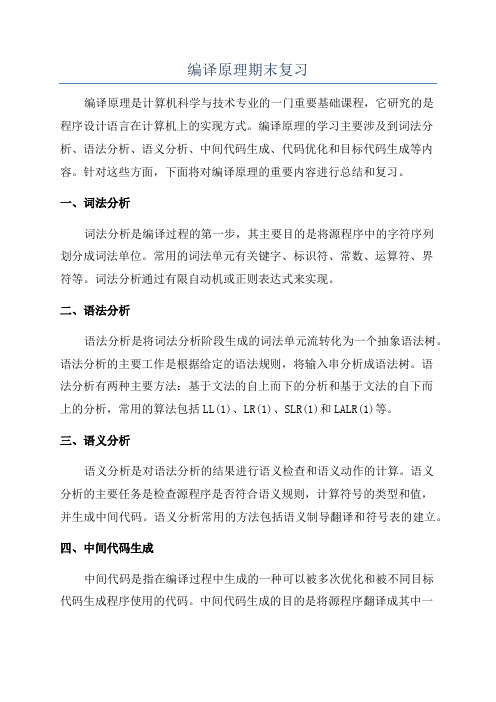
编译原理期末复习编译原理是计算机科学与技术专业的一门重要基础课程,它研究的是程序设计语言在计算机上的实现方式。
编译原理的学习主要涉及到词法分析、语法分析、语义分析、中间代码生成、代码优化和目标代码生成等内容。
针对这些方面,下面将对编译原理的重要内容进行总结和复习。
一、词法分析词法分析是编译过程的第一步,其主要目的是将源程序中的字符序列划分成词法单位。
常用的词法单元有关键字、标识符、常数、运算符、界符等。
词法分析通过有限自动机或正则表达式来实现。
二、语法分析语法分析是将词法分析阶段生成的词法单元流转化为一个抽象语法树。
语法分析的主要工作是根据给定的语法规则,将输入串分析成语法树。
语法分析有两种主要方法:基于文法的自上而下的分析和基于文法的自下而上的分析,常用的算法包括LL(1)、LR(1)、SLR(1)和LALR(1)等。
三、语义分析语义分析是对语法分析的结果进行语义检查和语义动作的计算。
语义分析的主要任务是检查源程序是否符合语义规则,计算符号的类型和值,并生成中间代码。
语义分析常用的方法包括语义制导翻译和符号表的建立。
四、中间代码生成中间代码是指在编译过程中生成的一种可以被多次优化和被不同目标代码生成程序使用的代码。
中间代码生成的目的是将源程序翻译成其中一种中间形式,便于进一步优化和生成目标代码。
中间代码生成的方法有三地址码、四地址码和虚拟机代码等。
五、代码优化代码优化是编译过程中的重要环节,其主要目的是对中间代码进行优化,使得生成的目标代码更加高效和紧凑。
代码优化使用各种数据流分析、指令调度和寄存器分配等技术,常用的优化方法有常量传播、公共子表达式消除、代码移动和死代码消除等。
六、目标代码生成目标代码生成是将中间代码转化为目标机器代码的过程,目标代码生成需要考虑目标机器的特性和限制。
目标代码生成包括指令选择、寻址方式的选择和寄存器分配等步骤。
常用的技术有基于各种寻址方式的代码选择算法、寄存器分配算法和指令调度算法等。
编译原理 总复习

13
■ 语言的形式定义
4、句型和句子
G = (VT, VN, P, S),S=>* a ,a ∈ (VTVN)* 称a 为句型。 a ∈ VT* ,称a为句子。
例:设有文法G[S]: S01 | 0S1 请分别判断:01,000S111,0SS0,0011,0S1是该 文法的句子还是句型?
句型与句子区别:句型由终结符和非终结符构成,句
+
T
F
F i
24
短语 (每棵子树的叶组成短语):
(E+T)*i+F是句型(E+T)*i+F相对于E的短语; (E+T)*i是句型(E+T)*i+F相对于E、T的短语; (E+T)是句型(E+T)*i+F相对于T、F的短语; E+T是句型(E+T)*i+F相对于E的短语; i是句型(E+T)*i+F相对于F的短语; F是句型(E+T)*i+F相对于T的短语。 简单短语 (每棵简单子树的叶组成简单短语): E+T是句型(E+T)*i+F相对于E的简单短语; i是句型(E+T)*i+F相对于F的简单短语; ( F是句型(E+T)*i+F相对于T的简单短语。 E 句柄 (最左简单子树的叶组成句柄): T F E + ) T
3
3. 字符串(字) 符号的有穷序列称为符号串。 例如有字母表 ={a,b,c},则有字符串 a,b,ab,ba,…… 符号串总是建立在某个特定字母表上的,且只能 由字母表上的有穷多个符号组成。 符号串中符号的顺序很重要,例如ab和ba就是两个 不同的符号串。不包含任何符号的符号串,称为空符 号串,用ε表示。空符号串由0个符号组成,其长度 |ε|=0
编译原理总复习课件

词法分析是编译过程中的第一个阶段,其任务是识别源程序中的单词或符号,并将其转换为词法单元或标记。
详细描述
词法分析,也称为扫描或词法扫描,是编译过程中的一个重要阶段。其主要任务是从左到右读取源程序中的字符 ,识别出其中的单词或符号,并将它们转换为一种中间表示形式,即词法单元或标记。这些词法单元或标记将作 为语法分析器的输入,用于进一步的语法和语义分析。
自顶向下的语法分析
01
自顶向下的语法分析方法从抽象语法树的顶端开始,逐步向下 进行解析。
02
常用的自顶向下的语法分析算法有预测分析算法和移进-规约算
法。
自顶向下的语法分析方法在处理某些复杂的嵌套结构时可能会
03
遇到问题。
自底向上的语法分析
自底向上的语法分析方法从抽象语法树的底端开 始,逐步向上进行解析。
03
代码优化
对中间代码进行优化,提高生成代码的执行 效率。
05
02
语法分析
根据语法规则将词法分析阶段产生的单词或 符号组装成抽象语法树(Abstract Syntax Tree, AST)。
04
中间代码生成
将抽象语法树转换成中间代码,通常 是三地址代码。
06
代码生成
将中间代码转换成目标机器代码,便于执行。
词法分析器的实现
要点一
总结词
词法分析器的实现可以采用手工编写或工具辅助的方式, 常用的工具有Lex和Flex等。
要点二
详细描述
词法分析器的实现可以采用多种方式。一种常见的方法是 手工编写一个词法分析器,根据语言的词法规则和语法规 则,逐一处理源程序中的字符。另一种方法是使用工具辅 助生成词法分析器,如Lex和Flex等工具可以根据预定义的 规则自动生成词法分析器。这些工具可以大大简化词法分 析器的编写过程,提高开发效率。
编译原理复习(有答案)
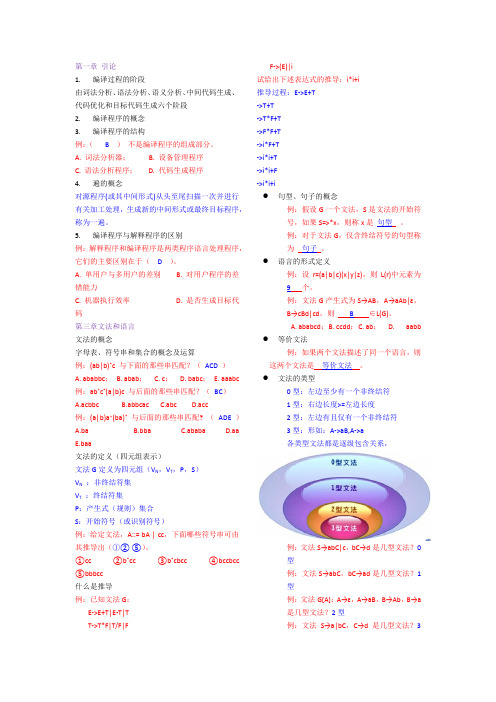
第一章引论1.编译过程的阶段由词法分析、语法分析、语义分析、中间代码生成、代码优化和目标代码生成六个阶段2.编译程序的概念3.编译程序的结构例:(B)不是编译程序的组成部分。
A. 词法分析器;B. 设备管理程序C. 语法分析程序;D. 代码生成程序4.遍的概念对源程序(或其中间形式)从头至尾扫描一次并进行有关加工处理,生成新的中间形式或最终目标程序,称为一遍。
5.编译程序与解释程序的区别例:解释程序和编译程序是两类程序语言处理程序,它们的主要区别在于(D)。
A. 单用户与多用户的差别B. 对用户程序的差错能力C. 机器执行效率D. 是否生成目标代码第三章文法和语言文法的概念字母表、符号串和集合的概念及运算例:(ab|b)*c 与下面的那些串匹配?(ACD)A. ababbc;B. abab;C. c;D. babc;E. aaabc例:ab*c*(a|b)c 与后面的那些串匹配?(BC)A.acbbcB.abbcacC.abcD.acc例:(a|b)a+(ba)*与后面的那些串匹配? (ADE)A.baB.bbaC.ababaD.aaE.baa文法的定义(四元组表示)文法G定义为四元组(V N,V T,P,S)V N:非终结符集V T:终结符集P:产生式(规则)集合S:开始符号(或识别符号)例:给定文法,A::= bA | cc,下面哪些符号串可由其推导出(①② ⑤)。
①cc ②b*cc ③b*cbcc ④bccbcc ⑤bbbcc什么是推导例:已知文法G:E->E+T|E-T|TT->T*F|T/F|FF->(E)|i试给出下述表达式的推导:i*i+i 推导过程:E->E+T->T+T->T*F+T->F*F+T->i*F+T->i*i+T->i*i+F->i*i+i●句型、句子的概念例:假设G一个文法,S是文法的开始符号,如果S=>*x,则称x是句型。
- 1、下载文档前请自行甄别文档内容的完整性,平台不提供额外的编辑、内容补充、找答案等附加服务。
- 2、"仅部分预览"的文档,不可在线预览部分如存在完整性等问题,可反馈申请退款(可完整预览的文档不适用该条件!)。
- 3、如文档侵犯您的权益,请联系客服反馈,我们会尽快为您处理(人工客服工作时间:9:00-18:30)。
Source code
Scanner
Compiling process
Tokens Parser Syntax Tree
Semantic analyzer Annotated Tree Source code optimizer
Literal table
Symbol table
Error handler Auxiliary components that interact with some phases
NFA Regular expressions Minimiz
DFA
Lexical Specification
Table-driven Implementation of DFA
Parser
• • • • CFG: production Derivation, leftmost and rightmost parse tree, abstract syntax tree Top-down and bottom-up
5 digit val=4 base=8 4
3
Code generation
• •
– –
Intermediate code generation TAC
Attribute grammar for generating three-address code Code Generation for If- and While- Statements
Schematic Form of LR parser
Input a1 … ai … an $
Stack
Sm Xm Sm-1 Xm1 … S0 $
LR Parsing Program
Output
action
goto
Parsing Table
A LR(0) DFA
E→T+E· S→E E → T; E→T+E T → int T → ( E)
Parser
• LR parser
– Shift and reduce – Parsing table: action and goto – State
• Item • LR(0) DFA: Closure Operation and Goto Operation
– SLR(1) parser
• Only reduce A → ω if the next token t is in FOLLOW(A).
Intermediate code Code generator Target code
Target code optimizer
Target code
Scanner
• Regular expression + automaton • NFA,DFAs • Convert NFAs to DFAs.
– Predictive – lookahead
Parser
• Top-down:
– LL(1) grammar – FirstSet and FollowSet
• nullable nontermianls
– Left Factor and Left Recursion
LL(1) Grammar
•
– –
A grammar is LL(1) grammar if the following conditions are satisfied:
For each production A → α1|α2|…|αn , for all i and j, 1≤i, j ≤ n, i≠j , First(αi) ∩First(αj) = Φ For each nonterminal A such that First(A) contains ε, First(A) ∩Follow(A) = Φ.
E → T ·; ② E→T·+E
;
T
T
T → (·E) ④ E → · T; E→·T+E T → · int T → · (E)
(
E → T ;· ⑧
)
Semantic analysis
• Attribute Grammar
– SDD – Dependency Graphs- Evaluation Order – Synthesized and Inherited Attributes
Parser
• Bottom-up
– Rightmost derivation traced in reverse(reduction) – Right sentential form – Handle: a string is a substring in right sentenial form that matches the right hand side of a production – viable prefix
Parser
• Top-down:
– Recursive-Descent parser and LL(1) parser – LL(1) parser
• LL(1) Parsing Tables
‘$’ is used to mark the end of the input strings
Parsing stack stores symbols waiting to matched in parsing the be
Repeat the following two steps for each nonterminal A and production choice A→ α 1. For each token ‘a’ in First(α), add A→ α to the entry M[A,a] 2. if ε is in First(α), for each element ‘a’ of Follow(A) (token or $), add A→ α to M[A,a]
a
+
b
$
Input
X Y S $
‘$’ is used to mark the bottom of the stack
predictive parser
Output
parsing table
Hale Waihona Puke LL(1) Parse Tables
•
–
The Construction of Parsing Tables
start
⑩
E
S→E ·
E
⑥
+ int
E→T+·E ③ E → · T; E→·T+E T → · int T → · (E)
int T ( int
T → (E)·
)
⑨
T → (E·) ⑤
E
S→ · E ① E → · T; E→·T+E T → · int T → · (E)
⑦ T → int ·
Attribute computations for the number 345o
based-num val=229
num val=28*8+5=229 base=8 num val=3*8+4=28 base=8 num val=3 base=8 digit val=3 base=8 digit val=5 base=8 basechar base=8 o
